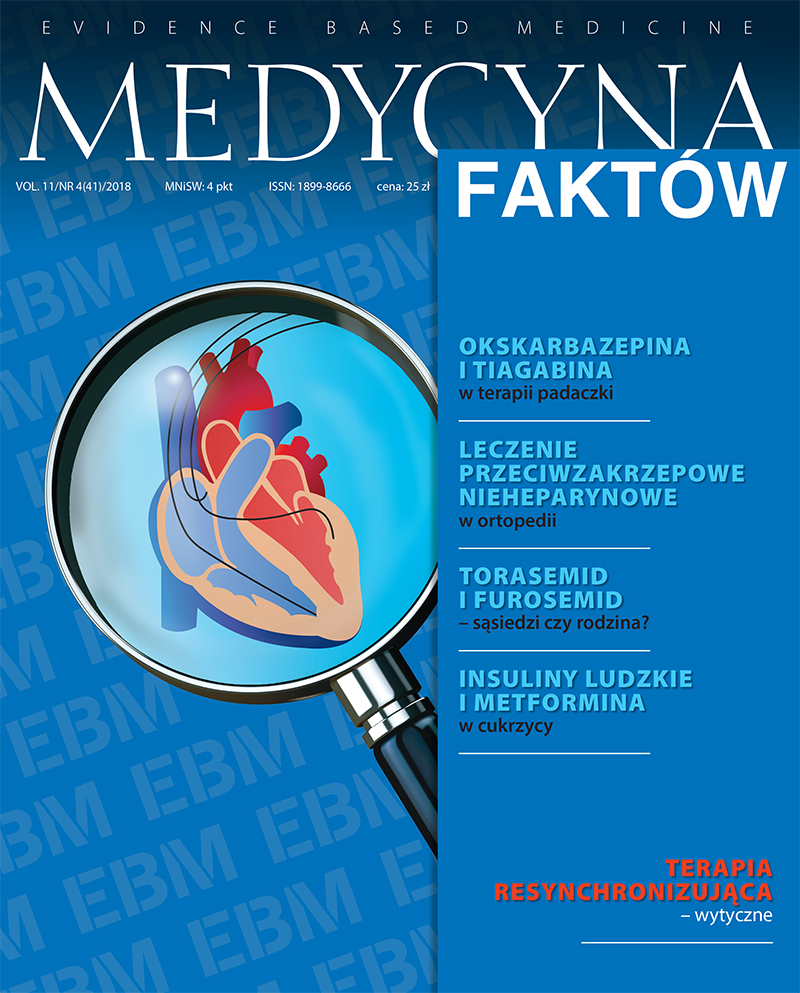Okskarbazepina – miejsce w terapii padaczki Artykuł przeglądowy
##plugins.themes.bootstrap3.article.main##
Abstrakt
Okskarbazepina (OXC) jest strukturalnym analogiem karbamazepiny (CBZ) o podobnym mechanizmie działania związanym z hamowaniem aktywacji kanałów sodowych. Zmiany struktury, choć niewielkie, są jednak istotne dla jej metabolizmu, tolerancji i interakcji z innymi lekami. OXC nie wykazuje większej niż CBZ skuteczności w napadach ogniskowych i uogólnionych toniczno- klonicznych, jest jednak nieco lepiej tolerowana. Obecnie głównym czynnikiem wyróżniającym OXC jest potwierdzone w ostatniej analizie bazy EURAP duże bezpieczeństwo stosowania jej w czasie ciąży. Wśród dzieci kobiet przyjmujących OXC w różnych dawkach wykazano ryzyko występowania wad wrodzonych podobne jak w populacji ogólnej i, co zastanawiające – mniejsze niż w przypadku karbamazepiny. Obok lewetyracetamu i lamotryginy OXC jest więc preferowanym lekiem do stosowania u kobiet w okresie rozrodczym i w ciąży.
##plugins.themes.bootstrap3.article.details##
Copyright © by Medical Education. All rights reserved.
Bibliografia
2. Marson A.G., Al-Kharusi A.M., Alwaidh M. et al.; SANAD Study Group: The SANAD study of effectiveness of carbamazepine, gabapentin, lamotrigine, oxcarbazepine, or topiramate for treatment of partial epilepsy: an unblinded randomised controlled trial. Lancet 2007; 369(9566): 1000-1015.
3. Nolan S.J., Muller M., Tudur Smith C., Marson A.G.: Oxcarbazepine versus phenytoin monotherapy for epilepsy. Cochrane Database Syst. Rev. 2013; 5: CD003615.
4. Nevitt S.J., Sudell M., Weston J. et al.: Antiepileptic drug monotherapy for epilepsy: a network meta-analysis of individual participant data. Cochrane Database Syst. Rev. 2017; 6: CD011412.
5. Guerreiro M. M., Vigonius U., Pohlmann H. et al.: A double-blind controlled clinical trial of oxcarbazepine versus phenytoin in children and adolescents with epilepsy. Epilepsy Res. 1997; 27(3): 205-213.
6. Wang Y., Chen Y.B., Zhang Y.Q. et al.: Oxcarbazepine oral suspension in pediatric patients with partial seizures and/or generalized tonic-clonic seizures: a multi-center, single arm, observational study in China. World J. Pediatr. 2017; 13(6): 551-559.
7. Qin J., Wang Y., Huang X.F. et al.: Oxcarbazepine oral suspension in young pediatric patients with partial seizures and/or generalized tonic- clonic seizures in routine clinical practice in China: a prospective observational study. World J. Pediatr. 2018; 14(3): 280-289.
8. Wu D., Chen L., Ji F. et al.: The effects of oxcarbazepine, levetiracetam, and lamotrigine on semen quality, sexual function, and sex hormones in male adults with epilepsy. Epilepsia 2018; 59(7): 1344-1350.
9. EURAP Study Group: Seizure control and treatment in pregnancy: observations from the EURAP epilepsy pregnancy registry. Neurology 2006; 66(3): 354-360.
10. Battino D., Tomson T., Bonizzoni E. et al.; EURAP Study Group: Seizure control and treatment changes in pregnancy: observations from the EURAP epilepsy pregnancy registry. Epilepsia 2013; 54(9): 1621-1627.
11. Tomson T., Battino D., Bonizzoni E. et al.; EURAP Study Group: Comparative risk of major congenital malformations with eight different antiepileptic drugs: a prospective cohort study of the EURAP registry. Lancet Neurol. 2018; 17(6): 530-538.
12. Weston J., Bromley R., Jackson C.F. et al.: Monotherapy treatment of epilepsy in pregnancy: congenital malformation outcomes in the child. Cochrane Database Syst. Rev. 2016; 11: CD010224.
13. Veroniki A.A., Rios P., Cogo E. et al.: Comparative safety of antiepileptic drugs for neurological development in children exposed during pregnancy and breast feeding: a systematic review and network meta-analysis. BMJ Open 2017; 7(7): e017248.
14. Harden C.L., Pennell P.B., Koppel B.S. et al.; American Academy of Neurology; American Epilepsy Society: Practice parameter update: management issues for women with epilepsy – focus on pregnancy (an evidence based review): vitamin K, folic acid, blood levels, and breastfeeding: report of the Quality Standards Subcommittee of the American Academy of Neurology and American Epilepsy Society. Neurology 2009; 73(2): 142-149.
15. Panchaud A., Cohen J.M., Patorno E. et al.: Anticonvulsants and the risk of perinatal bleeding complications: A pregnancy cohort study. Neurology 2018; pii: 10.1212/WNL.0000000000005944.
